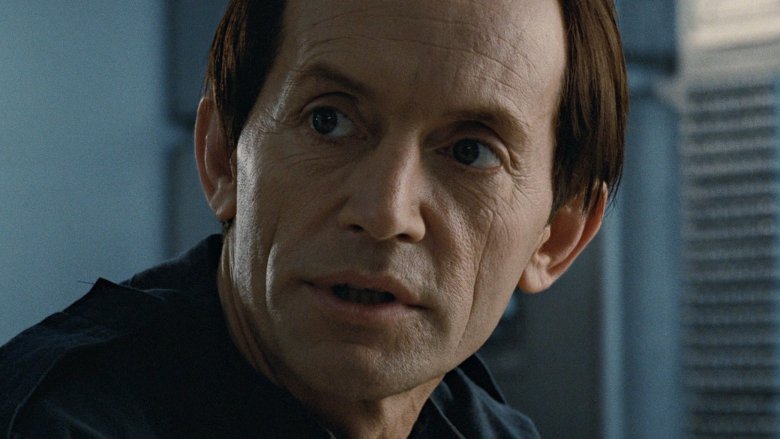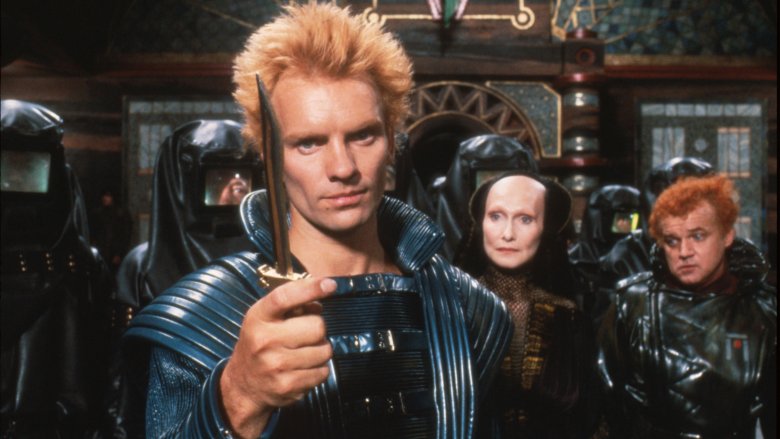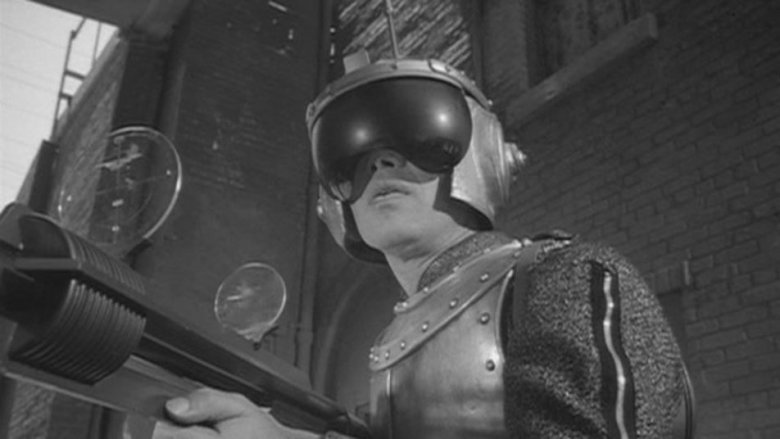The Untold Truth Of The Terminator
In 1984, James Cameron and Gale Anne Hurd were two unknown filmmakers setting out to make a guerrilla-style, low-budget action film about a killer robot from the future who travels back in time to murder a woman whose son might save the world. More than three decades later, Cameron is one of the world's most celebrated directors and Hurd is one of its most successful producers. The Terminator, the film they fought to make, is the breakout success that helped them get there.
Still revered and still launching sequels nearly 35 years after its release, The Terminator is regarded as one of the most influential sci-fi films of the 1980s, but the road to success wasn't always easy. From its feverish inspiration to strange early casting discussions to an iconic shot that almost got the crew in trouble with the law, here a few facts you might not have known about the making of The Terminator.
The idea came from a fever dream
Some films begin with a story, while others begin with an image. In the case of The Terminator, it was definitely the latter. The origin of James Cameron's breakout film came when he was in Rome, dealing with the awful experience he'd had with Piranha II: The Spawning. Tired and feverish, he had a dream of what would become the title character's nightmarish endoskeleton.
"Nightmares are a business asset; that's the way I look at it. I was sick, I was broke, I had a high fever, and I had a dream about this metal death figure coming out of a fire," he said. "And the implication was that it had been stripped of its skin by the fire and exposed for what it really was. When I have some particularly vivid image, I'll draw it or I'll write some notes, and that goes on to this day."
Cameron sketched what he saw, eventually showed the images to young producer Gale Anne Hurd, and The Terminator was born.
O.J. Simpson and Lance Henriksen almost played the Terminator
With the idea set in their minds, Cameron and Hurd collaborated on the film's script, then began to shop it around to studios as a low-budget, guerrilla-style film that Cameron would direct and Hurd would produce. In the early stages, to keep casting expenses down, they opted for relatively unknown stars, and wanted Lance Henriksen (who Cameron knew from Piranha II) to play the title role.
After numerous studios rejected the project, Orion Pictures finally agreed to finance The Terminator, but studio head Mike Medavoy had his own ideas about who should play the killer robot: O.J. Simpson, then best known as a beloved American football star who served as the TV spokesman for Hertz Rent-A-Car. Medavoy liked Simpson for his recognizability and his athleticism, but Cameron thought Simpson's public image at the time was just too likable and all-American to sell him as an unstoppable killing machine.
"Plus, frankly I wasn't interested in an African-American man chasing around a white girl with a knife," Cameron said. "It just felt wrong."
Medavoy also had his own ideas about who should play the film's time-traveling hero, Kyle Reese. For that, he had his sights set on a bodybuilder-turned-actor fresh off the success of Conan the Barbarian: Arnold Schwarzenegger. Cameron wasn't too wild about that idea, either.
Schwarzenegger accidentally won his role over lunch
Even if he didn't agree with Medavoy's idea of casting Schwarzenegger as Kyle Reese, Cameron knew he would have trouble getting around it. The Orion head was so keen on the notion that he actually approached Schwarzenegger and set up a lunch meeting with Cameron, which the director grudgingly accepted. Cameron later recalled he went to that lunch prepared to dismiss Schwarzenegger over "creative differences," but then something interesting happened. Schwarzenegger, having read the script, starting talking about his ideas for the Terminator character, not because he thought he'd play him, but because he was intrigued by the concept. As the actor talked, Cameron began to study the light falling on his face and his "intensity," and realized that he may have just found his villain instead of his hero. Schwarzenegger, trying to build a career as a leading man, was hesitant, but Cameron assured him it would work out.
"But Cameron said that he'd shoot it in such a way that all the evil stuff that I do will be totally excused by audiences because I'm a cool machine," Schwarzenegger said. "And so cool that some of the people will cheer."
So Schwarzenegger took the role, and after a delay of several months because he was contractually obligated to go shoot Conan the Destroyer, he became The Terminator.
Sting was offered $350K to play Kyle Reese
With Schwarzenegger in the title role, the part of Kyle Reese — the freedom fighter who travels back in time to save Sarah Connor (Linda Hamilton) so she can be the mother to resistance leader John Connor, who turns out to be his son — was left unfilled. Numerous current and future stars were considered for Kyle Reese. At one point, Superman star Christopher Reeve was up for the part, which would have cost the production $1 million. Reeve ultimately passed, and other stars were considered, among them Mel Gibson, Matt Dillon, Kurt Russell, Tommy Lee Jones, and Scott Glenn. Even Bruce Springsteen was considered, though his agents didn't think he'd be receptive.
Perhaps the most out-of-the-box choice for the role, though, was Police frontman Sting, who was offered $350,000 in early 1983 to play the part. Sting turned it down because production on The Terminator would likely conflict with two other big projects: a Police world tour planned for that summer, and another science fiction film he'd signed on for, Dune. The role ultimately went to Michael Biehn, who clicked well enough with Cameron that he worked with him again for Aliens in 1986 and The Abyss in 1989.
Stan Winston was not the first choice to build The Terminator
Though Cameron had the red-eyed, metal endoskeleton of the title creature in his mind virtually from the beginning, once production got underway on The Terminator someone had to actually design and build the character, and find a way to make the T-800's machinery appear to slowly be exposed from beneath Schwarzenegger's skin. According to Hurd, when it came time to secure the film's financing, there was only one choice the bond company for the film wanted: Dick Smith, the legendary makeup artist who'd worked on everything from Taxi Driver to The Exorcist.
Unfortunately, when he was contacted about the film, Smith informed Hurd that — while he was a master at special makeup effects — he didn't do the kind of machine-based creature design required for a film like The Terminator. He did give her a recommendation for who could do it, though: Stan Winston. So, Winston was hired and his team got to work on what would become one of his greatest creations. The Terminator was a career-defining film for Winston, who went on to win four Academy Awards for his effects work, three of them for films he did with Cameron (one for Aliens and two for Terminator 2: Judgment Day).
Linda Hamilton ran throughout the film on a broken ankle
Though she famously turns into a well-trained, extremely fit warrior who's ready for anything by the time Terminator 2 rolls around, in the first film Sarah Connor is just an ordinary woman who happens to find herself in the extraordinary circumstance of being chased by a killer robot from the future. That meant that Linda Hamilton had to spend much of the film fleeing The Terminator, and that meant running. Lots of running. It would have been a strenuous role to play anyway, but it was made much more difficult when, just before shooting, Hamilton broke her ankle, and tore some ligaments for good measure.
"[Sarah Connor] had to run throughout the movie, and it was mostly Linda by the way, on a broken ankle that had to be wrapped every day," Hurd later recalled.
To make things easier on Hamilton, Hurd shuffled the production schedule around so that many of the scenes that involved running were shot near the end of principal photography. Still, most of the time when you see Sarah Connor running for her life in the film, that's Hamilton giving it her all on a wrapped, still-healing broken ankle.
Schwarzenegger tried to change his most famous line
The Terminator franchise has endured for more than three decades, producing four sequels (and counting), and through it all one line has remained a signature not just for the franchise, but for Schwarzenegger as a major action star: "I'll be back." The T-800 has barely any dialogue in the original film, but those three words were instantly iconic. It's hard to imagine the film without them now, but at one point during shooting Schwarzenegger apparently fought to change them.
According to Schwarzenegger, he felt he sounded odd when he tried to say "I'll" with his accent, and suggested to Cameron that he should instead say "I will be back," arguing that a machine would phrase it that way to avoid the contraction. Cameron's response: "I don't tell you how to act; don't tell me how to write." Cameron shot several takes of the scene and had Schwarzenegger deliver the same line a different way each time, then picked the best take. Almost immediately after the film was released, fans were approaching Schwarzenegger on the street to ask him to repeat it.
The final shot was almost stopped by a cop
Because they had both worked with legendary low-budget producer Roger Corman, Cameron and Hurd both believed in the efficacy of shooting The Terminator guerrilla style. Many shots were achieved without the proper location permits. This includes the film's final shot, featuring Sarah Connor driving off into the desert with a dog, recording audio tapes that she will one day pass on to her son John.
Getting the shot was already complicated by the fact that, while she was around for the close-ups leading up to the moment, Linda Hamilton was not available on the day they need to shoot the wide shot. So, Hurd drafted her assistant to serve as Hamilton's double, and drafted her mother's dog to play Sarah Connor's dog. With a skeleton crew, Cameron and Hurd headed out into the desert to wait for just the right time to get the perfect images of heat rippling over the highway. After spending hours out there alone, they finally saw a car approaching, and it turned out to be a police officer.
"[He] said, 'I need to see your permit for filming here.' And we didn't have one," Hurd recalled. "We said, 'Oh, officer, we're making a UCLA student film. We didn't know you needed permits.' And he said, 'Okay, you're fine, just take the camera off the road.' I don't know if that cop ever figured it out. [Laughs] Wherever he is, we thank him for not shutting us down."
The studio hated it
By the summer of 1984, The Terminator was nearing completion, and Cameron was ready to show an early cut of his film to executives at Orion. Little did he know that his movie was about to enter the distinguished fraternity of massive hits that studio executives balked at upon first seeing them. Cameron later called the screening "disastrous," and accused Medavoy of privately bashing the film only to reverse course and take credit for The Terminator after it was released. According to Hurd, executives disliked it so much that they were hesitant to even grant advance screenings to the press.
"They had such little faith in the movie that they didn't want to screen it for critics," she said. "The head of marketing almost said as much. And if you were Orion and you had Amadeus, which they had released five weeks before, and which did go on to win Best Picture, well, I can imagine them saying, 'Amadeus, The Terminator — which one doesn't fit?' I can't blame them now, but at the time I was devastated when they didn't like it."
Harlan Ellison has a credit because of a plagiarism claim
In The Terminator's closing credits, there's one entry that may seem odd to viewers not familiar with how it came about. It reads: "Acknowledgement to the works of Harlan Ellison." Ellison, a legendary science fiction author, received the credit (along with a settlement from the producers) after claiming that elements of the film are nearly identical to "Soldier," a 1964 episode of The Outer Limits which Ellison adapted from his own 1957 short story "Soldier from Tomorrow." The episode and the short story are about a soldier from the future who travels back in time.
According to Ellison, he began hearing about the similarities between "Soldier" and The Terminator while the film was still in production, and confirmed his suspicions after sneaking into one of the early screenings. Ellison has also claimed that an interview Cameron gave with Starlog magazine to promote the film originally included a deleted quote about The Terminator being inspired by old Outer Limits episodes. That was enough for Ellison to speak up, and he settled with the producers out of court. Cameron denied Ellison's claims and objected to his name being in the credits, but that didn't stop the acknowledgement.










